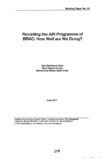Revisiting the ARI Programme of BRAC: how well are we doing?
Citation
lslam, Q. S., Ahmed, S. M., & Khan, M. A. U. (2011, June). Revisiting the ARI Programme of BRAC: how well are we doing? Research Reports (2011): Health Studies, Vol - XLIII, 219–261.Abstract
The ARI (Acute Respiratory Infection) control programme of BRAC has been in
operation for the last few years. No independent evaluation has so far been
conducted to explore how far the objectives of the programme have been achieved
in terms of raising awareness among the health workers and community people,
especially mother/caregivers about ARI, increasing capacity of health workers in
managing ARI cases in the community, and changing health-seeking behaviour of
mothers for appropriate and quick treatment. This is a cross-sectional population based
study comparing groups with or without ARI programmes. The study was
conducted in 30 upazilas where BRAC ARI control programme is being implemented
since 2007. In addition, 10 upazilas were selected from adjacent programme areas to
serve as control. The study included 2,800 mothers, 1,440 children with ARI
symptoms, and 238 community health workers who were actively involved in the
implementation of the ARI programme. The Shasthya shebikas (SS), frontline workers
of BRAC, appeared to have insufficient knowledge about ARI, its prevention and
other related information. Similarly, the level of awareness among mothers in terms of
recognition of symptoms of ARI and its prevention remains inadequate. However, the
awareness was higher in programme areas compared to non-programme areas. The
majority of the mothers heard about the community-based BRAe ARI control
programme, but they were unaware about the detail activities of the programme.
The overall management of ARI with respect to diagnosis and treatment by the health
workers especially SSs was not up to the expected level. They did not count the rate
of respiration regularly while diagnosing different stages of pneumonia. The SSs did
not tell mothers about the doses of co-trimmoxazole syrup in many cases, and about
the danger symptoms and signs, and prevention of ARI further. Sixty percent of
mothers would not seek ARI treatment from BRAC in programme areas. Mothers
preferred to go to the village doctors and drug sellers in both the programme and
non-programme areas. During health-seeking, one-fourth of the mothers did not seek
treatment, and one-fourth received spiritual treatment. The knowledge of BRAC SSs
and the mothers was not enough to deal with ARI management. Thus, it is difficult to
expect quick management of ARI to save life of the children in the community. Many
mothers still sought treatment from unqualified providers. Furthermore, the quality of
management by BRAC SSs was not of expected level. So, we conclude that many
children were at risk of mortality due to ARI. BRAG ARI programme should look into
the matter seriously to achieve the programme goal, and to reduce child morbidity
and mortality.

